Key takeaways:
- Understanding different e-book formats, such as EPUB and PDF, can greatly enhance the reading experience by affecting accessibility and interactivity.
- Digital rights management (DRM) can impose restrictions on sharing and using e-books, raising questions about the convenience of digital reading.
- Compatibility issues with e-book formats can lead to frustration; familiarizing oneself with file types and using multiple apps can help overcome these challenges.
- Prioritizing compatibility, choosing reputable sources, and reading reviews are essential when selecting e-books to ensure a satisfactory reading experience.
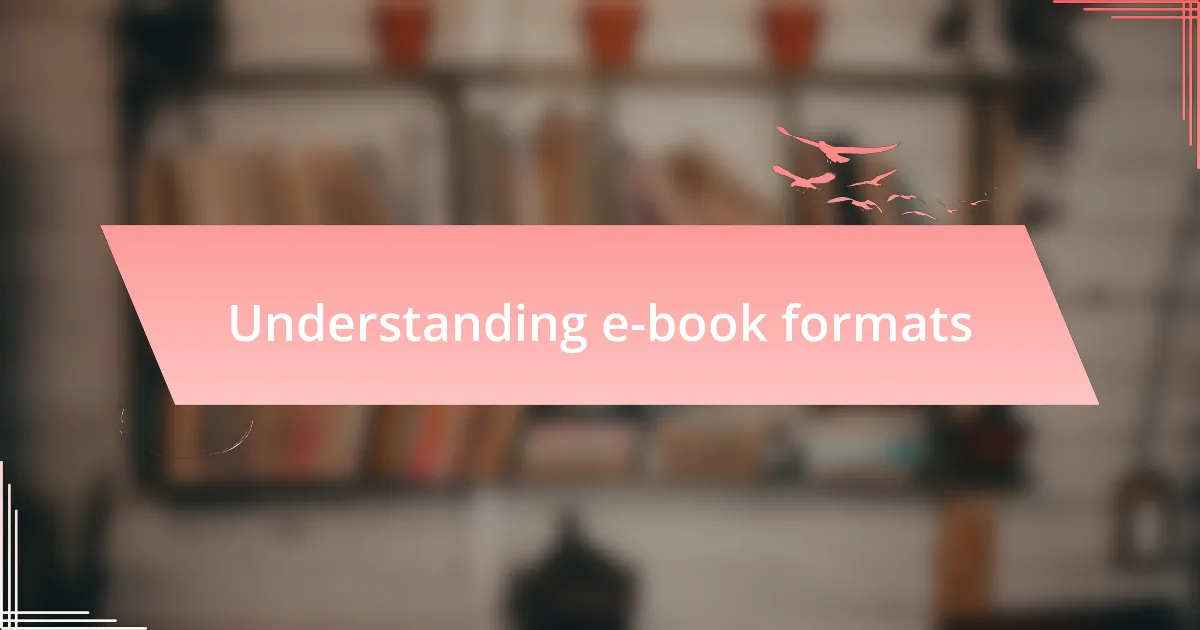
Understanding e-book formats
When diving into e-book formats, I remember my early frustration with incompatible files. I wanted to enjoy my favorite novels on my e-reader, but I kept bumping into formats like EPUB and MOBI, which promised different features. Have you ever felt overwhelmed by all the options? It can be quite a puzzle!
One aspect that stands out for me is the shift from text to a more interactive experience. For instance, PDFs can look amazing, but their static nature left me feeling disconnected, especially when I craved something more dynamic, like the reflowable text of an EPUB. This format allows reading on various devices without losing the integrity of the content. Isn’t it interesting how something as simple as format can profoundly impact how we experience a story?
Then there’s the issue of digital rights management (DRM), which can sometimes feel like a trap. I once bought a book only to find that I couldn’t transfer it to another device without jumping through hoops. That experience made me wonder: is the convenience of digital reading really worth the restrictions that often come with it? It’s moments like these that encouraged me to explore my options more thoroughly, seeking formats that offer both accessibility and freedom.

Types of e-book formats
When it comes to e-book formats, I’ve discovered that their differences can significantly affect my reading experience. For instance, when I first downloaded a book in the AZW format, I was thrilled by its Kindle compatibility, but then I quickly realized that it locked me into Amazon’s ecosystem. Have you ever felt stuck like that, where a format limits your options rather than opens them up?
In my exploration, I found that EPUB is a champion among formats, allowing me to adjust the font, background color, and even the layout to fit my mood. I remember sitting on a park bench, switching to a dark theme during a sunset, feeling the words come alive as the sky changed colors. Isn’t it fascinating how a simple format can enhance not just readability but also the emotion tied to the story?
On the other hand, I’ve had my share of challenges with PDF files. They can be great for manuals or textbooks where layout matters, but reading a novel in PDF on my tablet often felt cumbersome. I recall trying to read a gripping thriller, but the experience was marred by constant zooming and scrolling, taking me out of the narrative. It makes me wonder how much a format can affect our connection with a book.
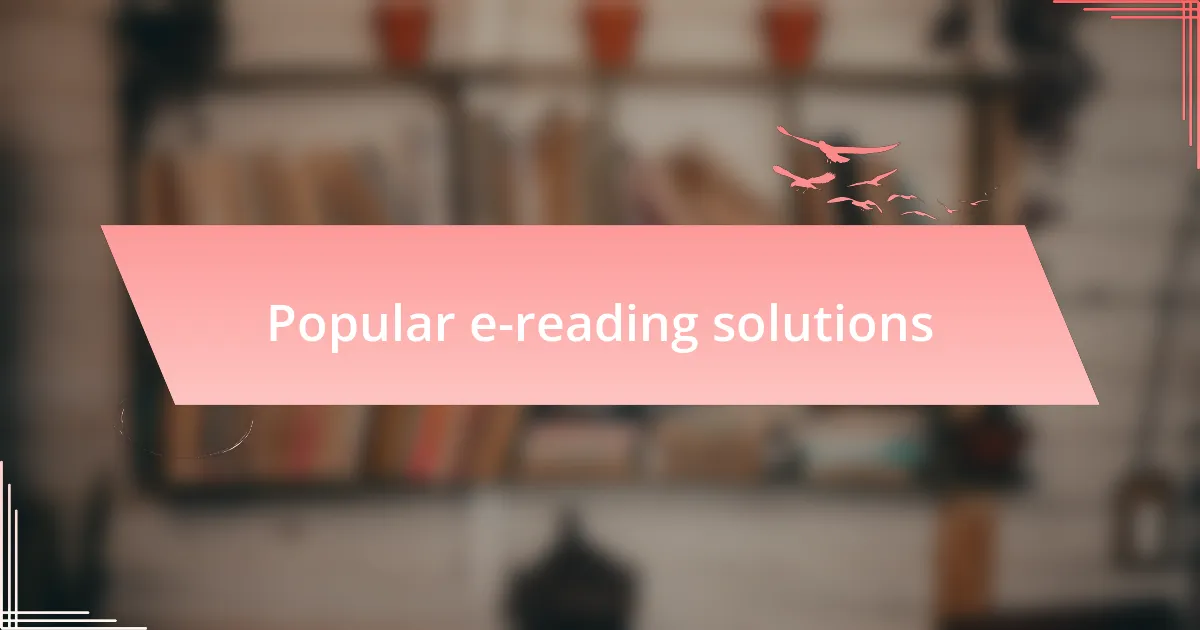
Popular e-reading solutions
I’ve often found myself gravitating toward dedicated e-reading solutions like Kindle and Kobo. Each platform offers its unique perks, but what fascinates me the most is how they tailor the reading experience to individual preferences. For example, there’s something satisfying about the seamless syncing across devices that Kindle provides—when I pause a book on my tablet, I can pick up right where I left off on my phone. Have you ever cherished that level of convenience?
Then there’s the option of using apps like Libby or OverDrive, which lets me borrow e-books from my local library right on my device. I’ll never forget the thrill of discovering a hidden gem I’d never heard of, simply because it was available for free. Isn’t it delightful how technology can connect us to stories without cost?
Some readers swear by reading solutions like Smashwords or Draft2Digital, emphasizing their extensive indie author catalogs. I once stumbled upon an engaging novella through Smashwords that completely changed my views on self-published content. It made me think—how many hidden treasures are there out there, waiting for someone to uncover them?
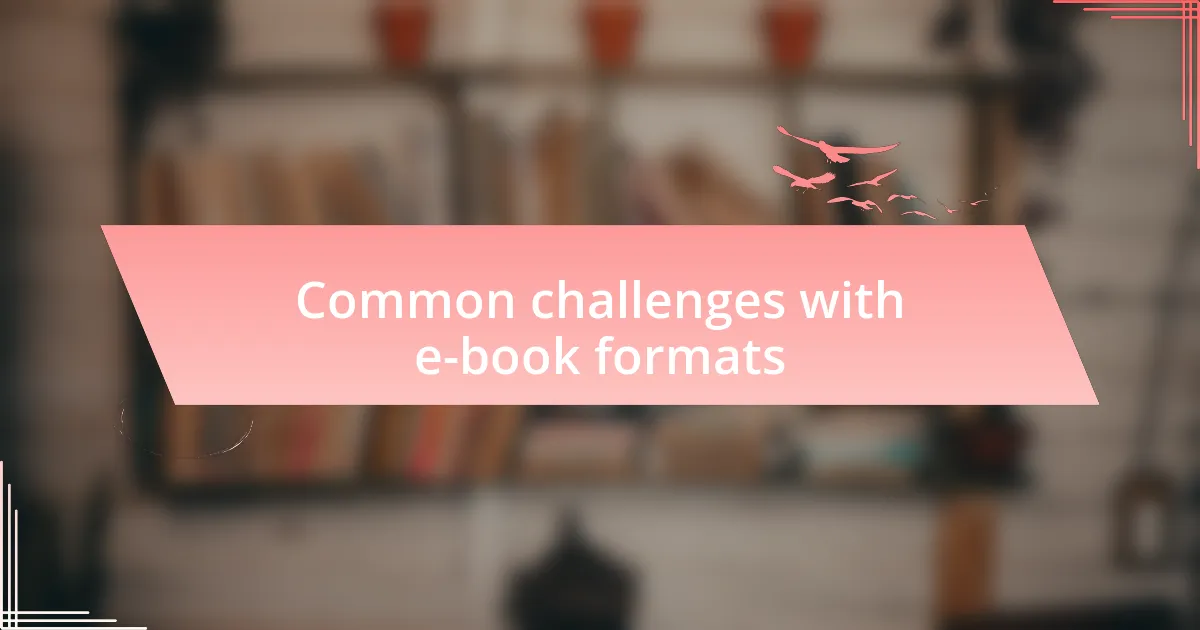
Common challenges with e-book formats
There are a few hurdles I’ve encountered with e-book formats that can be quite frustrating. One challenge that stands out is the inconsistency in formatting across different platforms. I still remember trying to read a beautifully illustrated book on an app that didn’t support the visuals well, diminishing the entire experience. Have you ever felt that sense of disappointment when the technology fails to do justice to the content?
Another common issue I’ve faced is the dreaded DRM, or Digital Rights Management. It’s meant to protect authors and publishers, but I often feel restricted by it. I recall wanting to share a favorite e-book with a friend, only to realize that the format made it impossible. Isn’t it ironic how something designed to safeguard can sometimes stifle the very sharing that enhances our reading community?
Finally, I often find myself wrestling with file compatibility issues. I can’t tell you how many times I’ve downloaded an e-book, only to discover it wasn’t supported by my preferred reader. This made me think about why there isn’t a more universal standard within the e-reading ecosystem, ensuring that every book could be enjoyed on any device. Have you encountered this type of frustration too? It really underscores the need for more user-friendly solutions in our digital reading adventures.
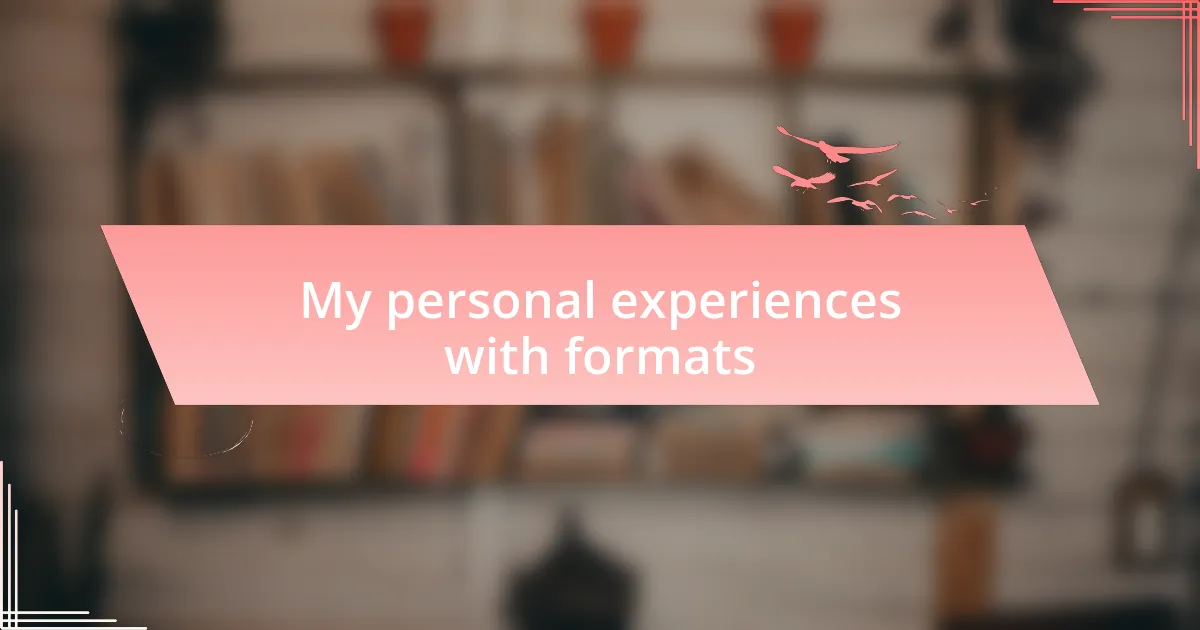
My personal experiences with formats
One of my more memorable experiences with e-book formats was when I decided to switch to a more specialized reading app that promised better features. Excited to dive into a new novel, I was met with clunky navigation and an interface that felt more like a maze than a reading platform. Have you ever thought you found the perfect tool, only to be let down by its execution?
There was one instance where I spent hours sorting through various file types to read a classic I adored. I finally found the right format, only to realize the annotations I wanted to access were only available in a different version. It made me wonder if I was chasing a seamless reading experience or simply compounding my own frustration with technicalities.
When I tried reading an e-book in a comic format, I had high hopes for a rich visual experience. Unfortunately, the format I used didn’t do justice to the vibrant artwork and the panels became hard to follow. Have you ever experienced a format so poorly executed that it drained the joy out of reading? It’s moments like these that highlight the significance of using the right format, especially for visual storytelling.
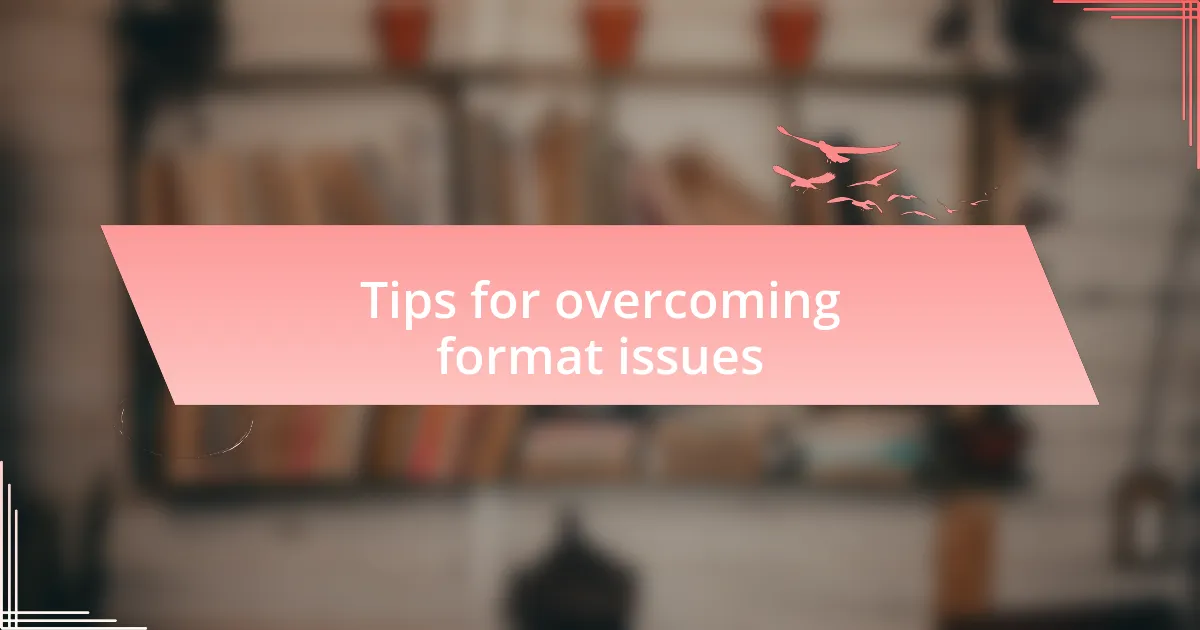
Tips for overcoming format issues
One effective strategy I’ve uncovered for tackling format issues is to familiarize myself with the different file types and their compatibility. For instance, I once struggled with a tricky PDF that wouldn’t display correctly on my e-reader. By digging into the details, I learned that converting it to an EPUB format not only solved the problem but enhanced my reading experience significantly. Have you looked into whether your files are the right type for your device?
Another tip is to use multiple apps to avoid getting stuck with just one option. I had this eye-opening moment when I tried an alternative app and discovered features that made reading much smoother. Sometimes, a simple switch can open up a world of enhancements, so don’t hesitate to explore beyond your first choice. Isn’t it amazing how a little experimentation can lead to a more enjoyable reading journey?
Lastly, seeking out community recommendations can save you from the trial-and-error grind I experienced. After joining a few online forums, I found a wealth of suggestions on managing format challenges. One fellow reader pointed me toward a conversion tool that transformed my e-books into readable formats effortlessly. Have you tapped into the collective wisdom of other e-readers? It might just lead you to solutions you hadn’t considered.
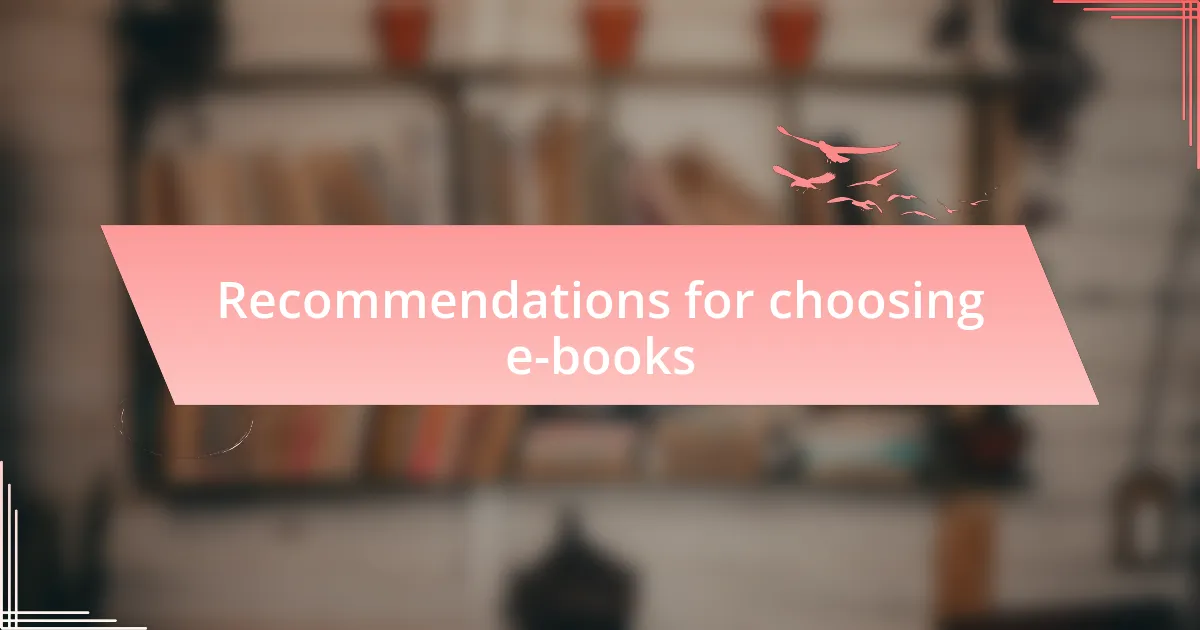
Recommendations for choosing e-books
When selecting e-books, I often prioritize compatibility with my devices. I remember an instance where I purchased a highly recommended e-book, only to find it wouldn’t sync with my favorite e-reader. It was frustrating, but I quickly learned to check the format details before buying. Have you ever been caught in a similar situation?
Additionally, consider the source of your e-books. There’s something comforting about knowing a reputable platform distributes the content I choose. My first experience with an obscure website resulted in a dodgy file that not only had formatting issues but also lacked the editorial quality I expected. It was a disappointing realization that led me to stick with well-known retailers that guarantee a higher standard. How confident are you in the reliability of your e-book sources?
Lastly, don’t underestimate the importance of reading reviews before downloading or purchasing an e-book. I’ve been pleasantly surprised by the insights shared by other readers. Their feedback helped me uncover gems I might have overlooked and avoid duds that weren’t worth my time. Is there a particular review you recall that influenced your reading choices?